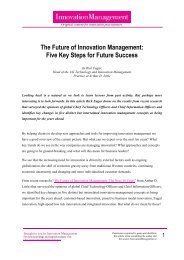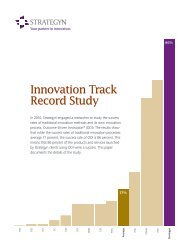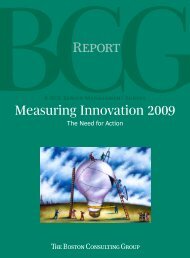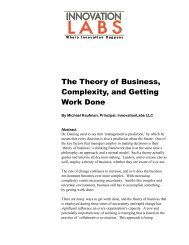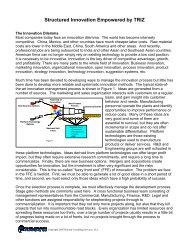the innovation master plan introduction - Innovation Management
the innovation master plan introduction - Innovation Management
the innovation master plan introduction - Innovation Management
You also want an ePaper? Increase the reach of your titles
YUMPU automatically turns print PDFs into web optimized ePapers that Google loves.
<strong>the</strong> <strong>innovation</strong> <strong>master</strong> <strong>plan</strong>: <strong>the</strong> CEO’s guide to <strong>innovation</strong> by Langdon Morrisspecial edition for <strong>Innovation</strong><strong>Management</strong>.com<strong>introduction</strong>13<strong>innovation</strong> that real economic growth occurs, because <strong>the</strong> underlying economicimpact of <strong>innovation</strong> makes resources more productive, which is literally how wealthis created. Hence, <strong>innovation</strong> is crucial to <strong>the</strong> economic viability of nations, while<strong>the</strong> lack of <strong>innovation</strong> is likewise an indicator of imminent or eventual decline.And in this larger context of nations and entire economies <strong>the</strong> concept ofproductivity is also essential if we are to fully appreciate <strong>the</strong> importance of<strong>innovation</strong>. It is only by improving productivity that we improve <strong>the</strong> standard ofliving for people in a city, a nation, or on a <strong>plan</strong>et, and it is through <strong>innovation</strong>, andonly through <strong>innovation</strong>, that <strong>the</strong> productivity of our efforts is improved.Increased productivity in agriculture enabled humans to develop civilization;increased productivity throughout civilization led to <strong>the</strong> successive economicrevolutions of industry, transportation, communications, and now knowledge, uponwhich our astonishingly high standard of living is based. Without <strong>innovation</strong>, noneof that would have happened, and without fur<strong>the</strong>r <strong>innovation</strong> our own future wouldloom pretty darn depressing. But given <strong>the</strong> economic incentive that companies haveto propel <strong>the</strong> pursuit of <strong>innovation</strong> forward, we need not fear that <strong>the</strong> pace of<strong>innovation</strong> will slacken, which is good for society but problematic for manybusinesses. In fact, our business problem is often <strong>the</strong> opposite, too much <strong>innovation</strong>that’s causing so much change that we can’t keep up with it.Thus, as innovators drive microeconomic change in specific markets andmacroeconomic change in economies, <strong>the</strong>y also trigger creative destruction in <strong>the</strong>irsearch for commercial success and competitive advantage.The only solution carries with it a fair amount of irony: to deal with <strong>the</strong> changesbrought by <strong>innovation</strong> requires … more <strong>innovation</strong>, both in <strong>the</strong> specific solutions weoffer in <strong>the</strong> market, and also in our approaches to managing <strong>the</strong> entire process.Hence, a framework such as <strong>the</strong> one proposed in this book is itself a response to <strong>the</strong>underlying issues and challenges.<strong>innovation</strong> and customersBut <strong>the</strong> innovator’s role is only half of <strong>the</strong> economic equation. Customers are <strong>the</strong>ones who determine <strong>the</strong> value of <strong>innovation</strong>s because <strong>the</strong>y’re <strong>the</strong> ones who pay for<strong>the</strong>m. “Market behavior” is an aggregate reflection of every consumer’s drive to find<strong>the</strong> most attractive offers, and to maximize value received for <strong>the</strong> cost incurred. As<strong>innovation</strong> is <strong>the</strong> process of creating higher value offerings, buyers naturally gravitateto innovative products.Although perhaps “gravitate” is <strong>the</strong> wrong word. Perhaps it’s more accurate tosay that people are obsessed with <strong>innovation</strong>s. The capitalist system depends for itsdynamism on <strong>the</strong> market’s appetite for better value, which has shown itselfthroughout history to be unbounded and insatiable.Inherent in <strong>the</strong> dynamics of market demand is <strong>the</strong> process that drives competitionthrough <strong>innovation</strong>. Waves of change are launched by innovators, and <strong>the</strong>ncountered by competitors who innovate in order to defend <strong>the</strong>ir existing positions, orto attack with ambitions of <strong>the</strong>ir own. All of this serves only to drive <strong>the</strong> process ofchange still that much faster throughout <strong>the</strong> economy.It’s clear that in this environment, <strong>the</strong> future of every firm is determined largelywww.<strong>innovation</strong>management.se





